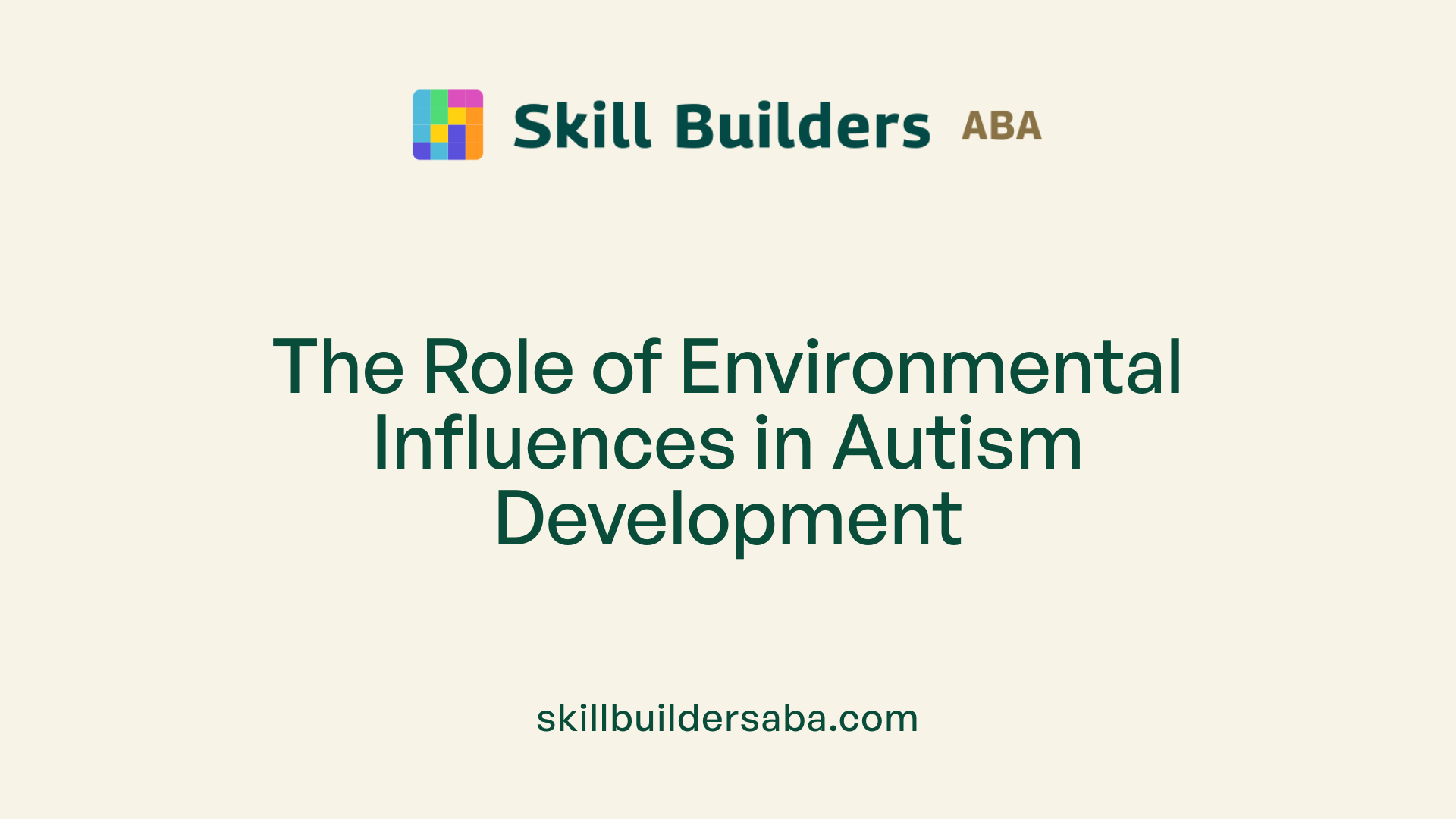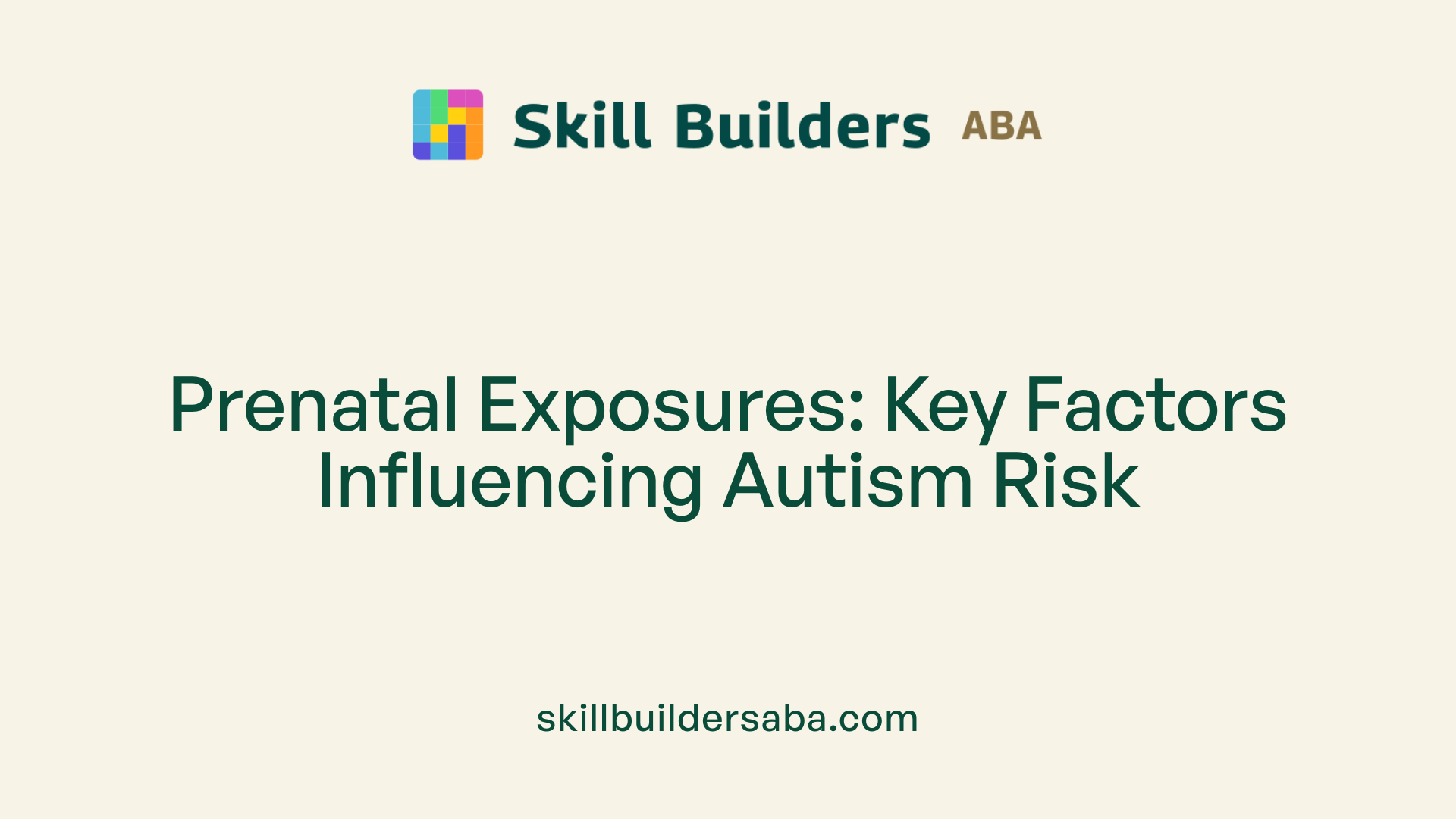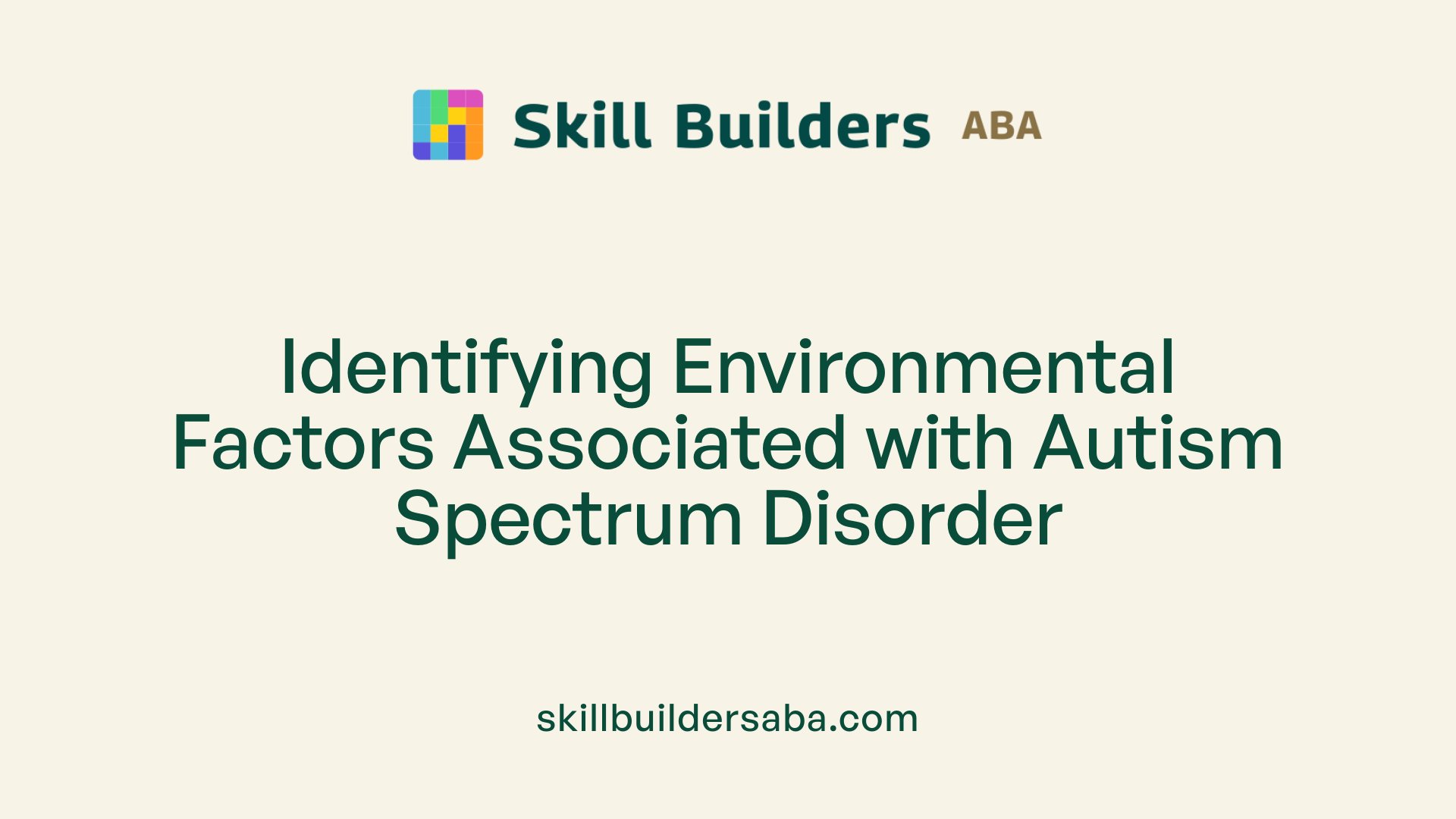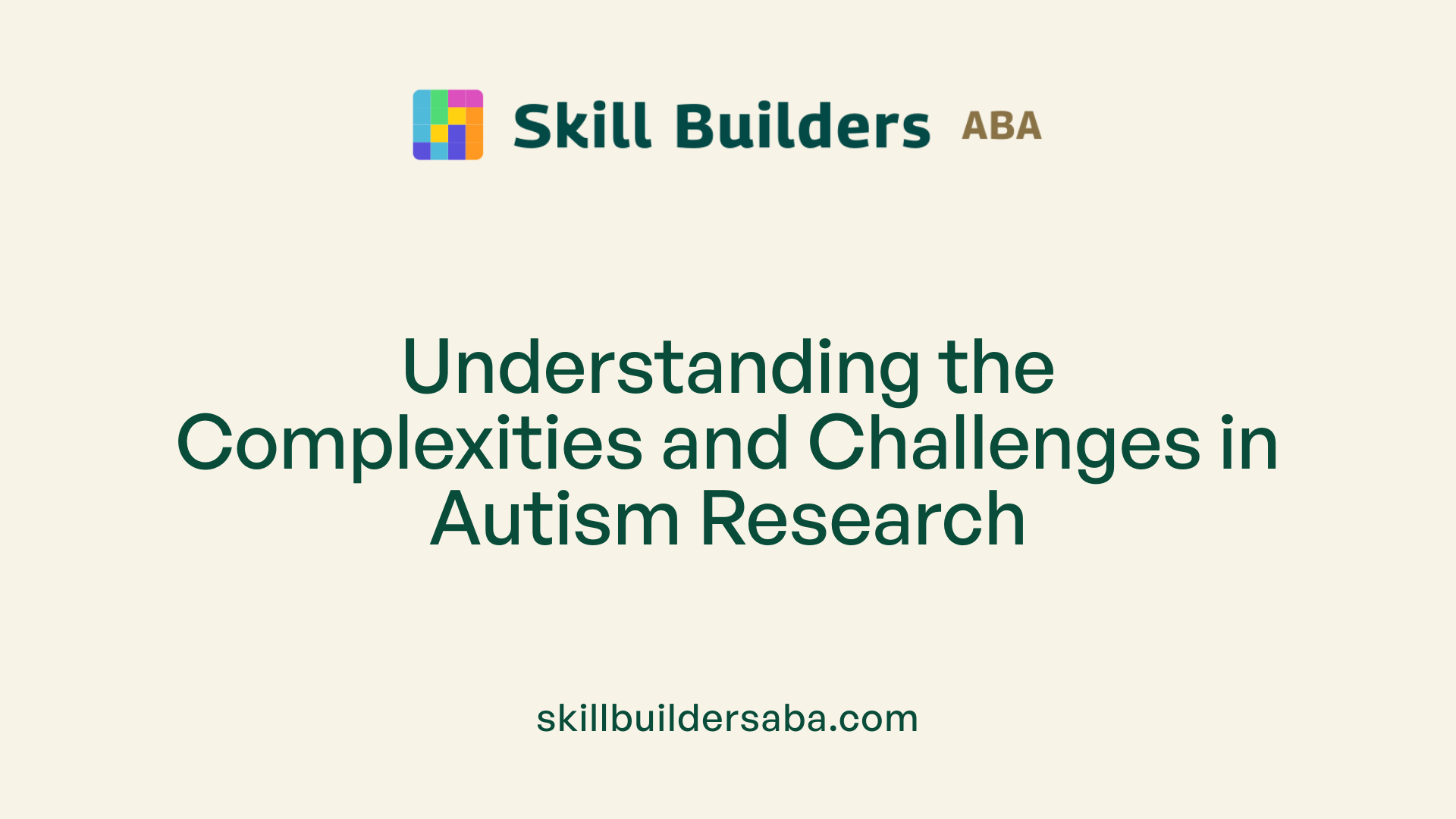Environmental Causes & Risk Factors Of Autism
Unraveling the Environmental Threads in Autism Spectrum Disorder

Understanding the complex interplay of environmental influences in autism
Autism Spectrum Disorder (ASD) is a multifaceted neurodevelopmental condition influenced by a combination of genetic and environmental factors. While genetics account for a significant portion of autism cases, increasing evidence points to various environmental risk factors that can affect brain development, especially during prenatal and early life stages. This article explores the environmental causes and risk factors associated with autism, shedding light on the mechanisms, research findings, and ongoing challenges in this vital area of study.
Environmental Risk Factors Associated with Autism Spectrum Disorder
What are the environmental risk factors associated with autism spectrum disorder?
Research indicates that multiple environmental factors may contribute to the development of autism spectrum disorder (ASD). These risks often interact with genetic predispositions, affecting early brain development.
One significant factor is parental age at conception. Both advanced maternal and paternal ages, especially paternal age over 34, have been associated with increased ASD risk. This may result from de novo mutations or epigenetic alterations in germline cells.
Prenatal exposure to certain chemicals such as thalidomide, valproic acid, and other pharmaceuticals has been linked to higher ASD risk. For instance, valproic acid used during pregnancy can interfere with fetal neural development. Similarly, exposure to toxicants like pesticides, air pollutants, and heavy metals during gestation can impact fetal neurodevelopment.
Maternal health and nutrition during pregnancy also play crucial roles. Maternal obesity, diabetes, and immune system conditions—including infections such as rubella and cytomegalovirus—are strongly associated with increased autism risk. Maternal immune activation due to infection can lead to inflammatory responses, cytokine elevation, and neurodevelopmental disruption in the fetus.
Infections during pregnancy, especially viral infections in the first trimester, significantly elevate ASD risk. Viral exposure can cause maternal immune responses that cross the placenta, impacting the developing fetal brain.
Preterm birth and low birth weight are critical postnatal factors. Babies born very early or with low weight are more susceptible to brain injuries and neurodevelopmental issues, including autism. Birth complications like oxygen deprivation, trauma, or umbilical cord issues further increase risk.
Environmental toxins such as air pollution, including particulate matter and nitrogen dioxide, and pesticides applied on farms or in residential areas, have been linked to higher autism prevalence. These exposures may cause oxidative stress, inflammation, and epigenetic modifications affecting neurodevelopment.
Additional environmental influences include the exposure to flame retardants, chemicals found in household electronics and furnishings, and phthalates used in plastics and personal care products. These endocrine disruptors may interfere with hormonal processes vital for brain development.
Research continues to explore how these environmental factors, often confounded by genetic and social influences, contribute to ASD. It is clear that environmental risks are part of a complex interplay, with studies estimating that environmental factors may account for approximately 40-50% of the variance in ASD liability.
Understanding these influences helps guide health policies and preventive measures, emphasizing the importance of maternal health, reducing exposure to environmental toxicants, and early intervention strategies.
| Environmental Factor | Specific Risks | Possible Mechanisms |
|---|---|---|
| Parental Age | Older parents, especially over 34 | Genetic mutations, epigenetic alterations |
| Prenatal Chemicals | Thalidomide, valproic acid | Disruption of neural development |
| Maternal Nutrition & Health | Obesity, diabetes, infections | Inflammation, immune activation |
| Birth Complications | Premature birth, low birth weight | Oxygen deprivation, trauma |
| Environmental Toxins | Air pollution, pesticides, heavy metals | Oxidative stress, epigenetic changes |
While evidence continues to evolve, these environmental factors are recognized as contributing to ASD risk within a multifactorial framework involving genetics and environmental interactions. Ongoing research aims to clarify their roles and to develop preventive strategies.
Scientific Evidence Supporting Environmental Influences in Autism
What scientific evidence supports the role of environmental influences in autism?
Research indicates that multiple environmental factors may play a part in the development of autism spectrum disorder (ASD). While genetics are deeply involved, accounting for approximately 80% of autism risk, environmental influences are also significant and are under active investigation.
One of the strongest types of evidence comes from studies examining prenatal exposures. For instance, maternal infections during pregnancy—particularly viral infections like rubella, influenza, and cytomegalovirus—have been linked to increased ASD risk. The immune response to these infections, involving elevated cytokines such as IL-17 and IL-6, can cross the placenta and influence fetal brain development.
Additionally, exposure to environmental toxicants during pregnancy has shown associations with autism. These include air pollution (especially traffic-related pollutants), pesticides, heavy metals like lead and mercury, and chemicals such as phthalates and bisphenol A (BPA). Such exposures often disrupt endocrine function or create oxidative stress, affecting fetal neurodevelopment.
Maternal health conditions during pregnancy, including diabetes, obesity, and immune disorders, further contribute to the risk. Maternal diabetes and obesity may cause inflammation and hormonal imbalances affecting fetal development. Autoimmune conditions and immune responses, characterized by the presence of autoantibodies targeting fetal brain tissue, are also linked with increased autism risk.
Advanced parental age, especially paternal age, has been consistently associated with higher ASD risk. This may be due to the accumulation of de novo genetic mutations or epigenetic alterations in germ cells, which influence early brain development.
In terms of medications, the use of drugs such as valproic acid and certain antidepressants like SSRIs during pregnancy has been associated with increased ASD risk. Valproic acid, in particular, disrupts fetal neural development, and is classified as a known teratogen.
Though these associations strengthen the hypothesis of environmental influence, many are complex and intertwined with genetic factors. For example, epigenetic mechanisms—changes in gene expression caused by environmental factors—are believed to mediate some effects. Such interactions can modify gene activity without altering the DNA sequence, influencing neurodevelopment.
Protective factors have also been explored. Prenatal supplementation with folic acid and omega-3 fatty acids appears to have beneficial effects, possibly reducing the susceptibility to ASD. These nutrients support neural development and modulate inflammatory responses.
In summary, a substantial body of scientific evidence underpins the role of various environmental factors in ASD risk. These include prenatal infections, exposure to pollutants and chemicals, maternal health conditions, and medication use during pregnancy. Despite these associations, causality is complex, often confounded by genetic predispositions and gene-environment interactions, making the field a dynamic area of ongoing research.
| Environmental Factors | Associated Risks | Notes |
|---|---|---|
| Air pollution (traffic-related) | Increased ASD risk | Especially during gestation and early life |
| Maternal infections (viral/bacterial) | Higher ASD risk | Congenital infections impact fetal brain |
| Pesticides and pesticides residues | Elevated risk | Widely studied in agricultural settings |
| Heavy metals (lead, mercury) | Potential contribution | Evidence still under investigation |
| Endocrine disruptors (phthalates, BPA) | Possible influence | Common in plastics and household products |
| Maternal health conditions | Elevated risk | Diabetes, obesity, immune disorders |
| Medications during pregnancy | Increased risk | Valproic acid, SSRIs; timing and dosage matter |
| Parental age | Higher risk | Especially paternal age over 34 |
Looking at the complex web of gene-environment interactions, it becomes clear that no single factor causes autism. Instead, a combination of genetic susceptibility and environmental exposures shapes the developing brain, influencing ASD risk. Ongoing research aims to better understand these mechanisms, which could lead to preventive strategies and targeted interventions.
How Environmental Factors Contribute to Autism Development

How do environmental factors contribute to the development of autism?
Environmental influences play a significant role in the complex development of autism spectrum disorder (ASD). They can impact neurodevelopmental processes, especially when interacting with genetic predispositions.
Research shows that prenatal exposure to various pollutants and chemicals increases the risk of autism. These include air pollution, pesticides, heavy metals such as lead and inorganic mercury, phthalates found in plastics and personal care products, and flame retardants present in household items. For instance, children exposed to higher levels of air pollutants around birth are more prone to develop ASD. Mothers living near farms that use pesticides or working with hazardous chemicals during pregnancy are also at a higher risk.
Environmental toxins may influence fetal brain development through mechanisms such as oxidative stress, endocrine disruption, inflammation, and interference with neurotransmitter signaling pathways. These effects may be more pronounced in genetically vulnerable individuals, supporting the idea of gene-environment interactions.
The health conditions of the mother during pregnancy further contribute to the environment's role. Conditions like diabetes, obesity, or immune system alterations such as maternal infections (e.g., rubella, cytomegalovirus, influenza) can disturb fetal development. Use of medications like valproic acid during pregnancy has been consistently linked with increased autism risk. Additionally, maternal immune activation due to infections can lead to increased cytokines crossing the placental barrier, adversely affecting fetal brain growth.
Birth complications are also significant environmental factors. Premature birth, low birth weight, fetal distress, not enough oxygen during delivery (hypoxia), and trauma are associated with higher ASD prevalence. These factors often involve hypoxia or inflammation impacting early brain development.
Postnatal exposures add another layer to environmental influences. Early-life factors such as neonatal jaundice, infections, vitamin deficiencies (notably vitamin D), and exposure to environmental toxins like lead or mercury can further affect neurodevelopment. Such exposures may cause epigenetic changes—modifications in gene expression—interacting with pre-existing genetic vulnerabilities.
Other environmental factors, including advanced parental age, especially paternal age over 34, are linked with increased autism risk. These are thought to involve de novo mutations and epigenetic changes in germline cells.
Though definitive causality is challenging to establish, accumulating evidence underscores the importance of environmental contributions. Many factors tend to act synergistically with genetic susceptibilities, heightening the likelihood of autism development.
Understanding these influences helps in formulating preventive strategies, such as minimizing exposure to harmful chemicals during pregnancy, managing maternal health conditions, and promoting healthier prenatal environments. Scientists continue to investigate how these multiple layers of environmental impact interact with genetic factors to better understand autism's origins and potentially reduce risk in future generations.
Impact of Prenatal Environmental Exposures on Autism Risk

What impact do prenatal environmental exposures have on autism risk?
Research indicates that various environmental exposures during pregnancy can influence the likelihood of developing autism spectrum disorder (ASD) in children. Among these, air pollution, pesticides, heavy metals, and maternal health conditions stand out as significant factors.
One of the most studied pollutants is particulate matter, especially fine particles like PM2.5, and ozone. Exposure to high levels of PM2.5 during the first two trimesters has been linked to increased ASD risk, as has exposure to ozone later in pregnancy. These pollutants can cross the placental barrier, potentially causing inflammation and oxidative stress that impair fetal brain development.
The critical windows during pregnancy—particularly early gestation—are especially sensitive to environmental toxins. Exposure during these periods may disrupt key neurodevelopmental processes, leading to variations in brain structure and connectivity associated with autism.
Maternal nutrition plays a vital role in moderating these risks. Adequate intake of folic acid, omega-3 fatty acids, and other protective nutrients before and during pregnancy can buffer the effects of harmful environmental toxicants. These nutrients help reduce oxidative stress and may influence epigenetic regulation—chemical modifications that change gene expression without altering DNA sequences—thus impacting neurodevelopment.
Genetic and epigenetic factors also contribute to individual differences in susceptibility. Certain genetic variations might make some fetuses more vulnerable to environmental insults, while epigenetic modifications can mediate the long-term impacts of prenatal exposures.
Timing and the specific type of environmental exposure are crucial. Early exposure to toxicants like pesticides and heavy metals, including lead and mercury, has been associated with higher ASD risk. The type, duration, and concentration of these exposures, combined with maternal health factors, influence the overall risk.
In summary, prenatal environmental exposures affect autism risk through complex interactions involving timing, type of environmental insult, and maternal nutritional status. These factors can lead to biological changes such as inflammation, oxidative stress, and epigenetic modifications that influence fetal brain development, potentially resulting in ASD.
This intricate relationship underscores the importance of minimizing exposure to environmental pollutants during pregnancy and ensuring proper maternal nutrition to reduce ASD risk and promote healthy neurodevelopment.
| Environmental Factor | Critical Window | Impact on Autism Risk | Additional Notes |
|---|---|---|---|
| PM2.5 (Particulate Matter) | First two trimesters | Increased risk | Crosses placenta, causes inflammation |
| Ozone | Late pregnancy | Elevated risk | Linked to oxidative stress |
| Pesticides | Early gestation | Higher susceptibility | Organization of neuronal networks |
| Heavy Metals (Lead, Mercury) | Throughout pregnancy | Potentially harmful | Impact gene expression via epigenetics |
| Maternal Nutrition | Preconception and pregnancy | May mitigate risks | Folic acid and omega-3s are protective |
What are sensitive windows during pregnancy?
Sensitive periods during pregnancy refer to specific times when the fetus is more vulnerable to environmental toxins. The first trimester, especially the first 8 weeks, is critical because of rapid brain development and neural tube formation. Exposure to pollutants or toxic substances during this window can disrupt fundamental neurodevelopmental processes.
Later in pregnancy, particularly the third trimester, brain growth continues with rapid synaptogenesis and neuron migration. Exposure to pollutants like ozone or heavy metals during this period may interfere with these processes, increasing ASD risk.
Overall, both early and late gestation stages are sensitive, but early prenatal periods are especially critical for neurodevelopmental integrity.
How does maternal nutrition influence effects of environmental factors?
Maternal nutritional status significantly influences how environmental exposures impact fetal brain development. Adequate intake of folic acid before conception and during early pregnancy has been shown to reduce neural tube defects and may lower ASD risk by supporting proper neural development.
Omega-3 fatty acids, especially DHA, are essential for brain and retinal development. Maternal supplementation can mitigate the adverse effects of environmental toxins, potentially by reducing oxidative stress and modulating epigenetic mechanisms.
Other nutrients like vitamin D, choline, and antioxidants also play roles in maintaining fetal neurodevelopment resilience against environmental challenges. Proper nutrition acts as a protective buffer, highlighting the importance of balanced prenatal care.
In what ways do genetics and epigenetics modify environmental risk?
Genetic predispositions influence individual sensitivity to environmental toxins. Certain gene variants involved in detoxification pathways, oxidative stress responses, and neurodevelopment may make some fetuses more susceptible to environmental insults.
Epigenetics, involving chemical modifications such as DNA methylation and histone modification, can be altered by environmental exposures. These changes can turn genes on or off, affecting fetal neurodevelopment pathways associated with ASD.
Environmental factors during pregnancy, like pollutant exposure, can induce epigenetic modifications that persist into childhood, affecting gene expression related to neural wiring and functioning.
When and what type of environmental exposures are most concerning?
Timing is essential, with early pregnancy exposures posing the highest risk due to the critical stages of brain development. Toxicants like pesticides and heavy metals are particularly concerning during this window.
Type of exposures include air pollutants, pesticides, endocrine disruptors (such as BPA and phthalates), and maternal infections. Each can influence different neurodevelopmental processes.
These exposures, especially when overlapping, can amplify risks via mechanisms including inflammation, oxidative stress, immune activation, and disruption of signaling pathways.
Understanding these patterns helps guide preventative strategies to minimize risk during vulnerable periods.
| Critical Window | Toxins of Concern | Mechanisms of Action | Preventive Measures |
|---|---|---|---|
| First trimester | Pesticides, heavy metals | Disruption of neural migration | Reduce exposure to pesticides and pollutants |
| Third trimester | Ozone, air pollution | Oxidative stress, inflammation | Limit outdoor activities during high pollution days |
This focus on the timing and nature of environmental impacts provides insights into how prenatal exposures shape neurodevelopmental outcomes, emphasizing prevention and maternal care as strategies to lower autism risk.
Common Environmental Exposures Linked to Autism

What are common environmental exposures linked to autism, such as infections, maternal health conditions, medications, or toxicants?
Research indicates that several environmental factors during pregnancy and early childhood can influence the risk of developing autism spectrum disorder (ASD). Exposure to infections during pregnancy, such as rubella, cytomegalovirus, and influenza, has been associated with an increased likelihood of ASD in offspring. These infections can activate the maternal immune system, leading to inflammatory responses that may disrupt fetal brain development.
In addition to infections, exposure to various toxicants plays a significant role. Pesticides are among the most studied chemicals linked to autism risk; women living near farms that use pesticides or working with hazardous chemicals during pregnancy have children with higher ASD likelihood. Other environmentally toxic substances such as phthalates, heavy metals like mercury and lead, and polychlorinated biphenyls (PCBs) have also been associated with neurodevelopmental alterations.
Air pollution, especially during gestation or early childhood, is strongly linked to ASD. Fine particulate matter (PM) and nitrogen oxides can cross the placental barrier, affecting fetal brain development. Air pollutants are thought to induce oxidative stress and inflammation, which may interfere with neural signaling.
Maternal health conditions that impact fetal development include obesity, diabetes, autoimmune diseases, and preeclampsia. These conditions may predispose the fetus to neurodevelopmental issues via inflammatory processes or metabolic disruptions.
Certain medications taken during pregnancy have been associated with increased autism risk. Valproic acid, an anti-epileptic drug, is among the most well-documented medications linked to ASD. Selective serotonin reuptake inhibitors (SSRIs), used for depression, also show an elevated risk, particularly when used during the first trimester.
Environmental exposures extend to toxic waste sites and industrial pollutants. These can introduce a mixture of chemicals into the environment that may interfere with fetal brain development through endocrine disruption, inflammation, or oxidative stress.
Overall, both genetic predispositions and environmental influences, especially during sensitive developmental windows, contribute to the complex etiology of autism.
Examples of Environmental Factors and Their Impact
| Environmental Factor | Exposure Type | Potential Impact | Evidence Strength |
|---|---|---|---|
| Pesticides | Maternal occupational or residential exposure | Disruption of neurodevelopment, increased ASD risk | Strong, multiple epidemiological studies |
| Heavy metals (mercury, lead) | Environmental contamination via water, air | Neurotoxicity, oxidative stress, synaptic disruption | Moderate, with ongoing research |
| Air pollution | Particulate matter, nitrogen oxides | Inflammation, oxidative stress, altered brain development | Strong, especially for prenatal exposure |
| Phthalates | Plastics, personal care products | Endocrine disruption, interference with hormone signaling | Emerging, mechanistic studies |
| Antibiotics and medications during pregnancy | Prenatal pharmaceutical exposure | Mitochondrial dysfunction, altered neurotransmitter systems | Variable, some associations with ASD |
| Environmental waste sites | Toxins and chemical runoff | Exposure to complex chemical mixtures affecting neurodevelopment | Limited, but concerning evidence |
How Do These Environmental Factors Interact with Genetics?
While genetics play a significant role in autism, environmental factors can influence gene expression and neurological development through epigenetic mechanisms. For instance, toxic exposures may modify DNA methylation or histone structure, leading to altered neural pathways. These gene-environment interactions can increase the susceptibility to ASD in genetically predisposed individuals.
In summary, environmental exposures during critical periods of development—ranging from maternal infections and health conditions to chemical toxins in the environment—are associated with an increased risk of autism. Continued research aims to clarify specific pathways and identify preventive strategies.
Interaction Between Environmental and Genetic Factors in Autism

How do environmental factors interact with genetic factors in autism etiology?
Autism spectrum disorder (ASD) is a complex condition influenced by both genetic and environmental elements. The interplay between these factors is crucial for understanding the development of autism.
Environmental factors affect gene expression through mechanisms called epigenetic modifications. These are changes that do not alter the DNA sequence but can turn genes on or off, influencing brain development. Examples include DNA methylation, histone modifications, and noncoding RNA activity. During critical periods of neurodevelopment, such as prenatal and early postnatal stages, environmental exposures can impact these epigenetic processes, thereby modifying the risk of autism.
Genetic predispositions often involve mutations or variations in genes related to synaptic function, neural connectivity, or brain structure. Notably, mutations in genes like NLGN, SHANK, and NRXN are associated with increased autism risk. These genetic vulnerabilities on their own might not cause autism but can be amplified or mitigated by environmental influences.
Environmental exposures such as advanced parental age, prenatal medication use (e.g., valproic acid or SSRIs), maternal infections, and pollutants like air pollution and pesticides can influence gene expression through epigenetic pathways. For example, maternal immune activation (MIA) due to infection can induce inflammatory responses that modify neural gene activity.
Further, factors such as oxidative stress, inflammation, and hypoxia during pregnancy or birth can negatively affect genes responsible for neural development, synaptic plasticity, and neurotransmitter regulation. These stressors may serve as pathways through which environmental influences interact with genetic susceptibilities.
Twin studies underline the importance of both heredity and shared environment in autism. Identical twins show higher concordance rates, but differences also exist, indicating that environmental factors can modify genetic risks.
In summary, environmental factors interact with genetic predispositions via complex gene-environment interactions and epigenetic mechanisms. These interactions influence neurodevelopmental processes, ultimately affecting the likelihood of developing autism.
| Aspect | Details | Additional Notes |
|---|---|---|
| Gene types | Synaptic genes (NLGN, SHANK, NRXN) | Mutations in these genes are linked to autism risk |
| Environmental influences | Maternal infections, pollutants, medications, parental age | Modify gene expression via epigenetics |
| Biological mechanisms | DNA methylation, histone modification, noncoding RNAs | Epigenetic regulation of neural development |
| Pathways involved | Oxidative stress, inflammation, hypoxia, immune activation | Affect genes involved in connectivity and plasticity |
| Twin studies | Higher concordance in identical twins, but environmental factors influence outcomes | Demonstrates interplay of genetics and environment |
Scientific Consensus and Research Challenges

What is the current scientific consensus on environmental contributions to autism?
The current scientific consensus acknowledges that autism spectrum disorder (ASD) arises from a combination of genetic and environmental influences. It is well-established that genetics play a substantial role, contributing approximately 80% of ASD risk, with over 400 genes implicated in the disorder. However, environmental factors during pregnancy, birth, and early childhood also contribute significantly, accounting for about 40-50% of the variance in ASD liability. Research highlights several prenatal exposures associated with increased autism risk, such as advanced parental age—especially paternal over 34—maternal health conditions like diabetes, autoimmune disorders, and infections, as well as exposure to environmental pollutants like air pollution, pesticides, and heavy metals. Additionally, medication use during pregnancy, including certain antiepileptic drugs like valproic acid, has been linked with higher ASD risk. Importantly, extensive studies have consistently shown that vaccines do not increase the risk of autism, dispelling long-standing misconceptions. The multifactorial nature of autism suggests that environmental factors can influence gene expression through mechanisms like epigenetic modifications, oxidative stress, and immune responses. Overall, science recognizes a complex interplay where environmental exposures during critical development windows may modify genetic susceptibility, although no single environmental factor has been identified as a direct cause.
What are the challenges faced in researching environmental causes of autism?
Investigating the environmental origins of autism presents numerous hurdles. One major challenge is the disorder's multifaceted etiology, involving intricate gene-environment interactions that are difficult to disentangle. Establishing causality remains problematic because many environmental exposures are common and often co-occur with other risk factors, complicating efforts to isolate specific causes. Furthermore, variability in study designs, populations, and measurement techniques leads to inconsistent findings. For example, measuring actual levels of pollutants like heavy metals or pesticides during pregnancy or early life is complex, and retrospective data collection may be subject to recall bias. Additionally, confounding factors such as parental age, socioeconomic status, maternal health, and access to healthcare can influence outcomes, making it hard to determine whether an observed association truly indicates causality. Another challenge is the long latency between exposure and diagnosis, often spanning years, which complicates tracking exposures and neurodevelopmental outcomes reliably. Given these obstacles, large-scale, longitudinal studies with meticulous exposure assessments and advanced statistical modeling are essential for clarifying environmental impacts on autism.
The complexity of autism etiology
Autism's origins are deeply complex, involving a dynamic interplay between multiple genes and various environmental factors. Genetic influences include both inherited variants and de novo mutations—new changes in the genetic code that occur in the embryo. These mutations affect neural development pathways, synaptic function, and brain connectivity. Environmental influences may modify or interact with these genetic factors. For example, prenatal infections like rubella or cytomegalovirus, maternal immune activation, exposure to pollutants, or medication use can alter developmental processes. Such factors can induce oxidative stress, inflammation, endocrine disruption, or epigenetic modifications, influencing gene expression without altering DNA sequences. The heterogeneity of ASD symptoms and varying severity levels further underscore the disorder's complex origins. This complexity requires a nuanced understanding that considers multiple biological pathways and environmental exposures occurring during sensitive developmental windows.
Role of gene-environment interaction
Gene-environment interactions are central to understanding autism. These interactions occur when environmental factors influence the expression of specific genes or when genetic predispositions modify responses to environmental exposures. Research indicates that children with certain genetic susceptibilities may be more vulnerable to environmental insults, such as pollutants or maternal infections, which can trigger or exacerbate neurodevelopmental disruptions. For instance, alterations in immune response genes might increase the impact of maternal inflammation or infection, contributing to ASD. Similarly, genetic variations affecting detoxification pathways may influence how pollutants like heavy metals affect fetal brain development. Understanding these interactions can help identify high-risk populations and lead to preventive strategies, emphasizing the importance of personalized approaches to autism risk assessment.
Need for large-scale studies
Addressing the uncertainties surrounding environmental contributions to autism necessitates expansive research efforts. Large-scale, multi-center cohort studies and meta-analyses improve statistical power to detect subtle effects and interactions. These studies can incorporate detailed exposure assessments—such as biomonitoring of pollutants—and comprehensive demographic and health data to control for confounding factors. Advanced technologies, like genomics, epigenomics, and metabolomics, enable researchers to explore biological pathways linking exposures and neurodevelopmental outcomes. Furthermore, longitudinal designs allow tracking exposures from conception through early childhood, providing insights into critical windows of vulnerability. Investing in such large-scale research is vital for developing evidence-based policies and interventions aimed at reducing environmental risks and ultimately improving neurodevelopmental health in the population.
The Intricate Puzzle of Autism's Environmental Origins
Understanding the environmental causes and risk factors of autism is paramount in unraveling the complex etiology of this neurodevelopmental disorder. The evidence underscores the multifactorial nature of autism, where environmental influences such as prenatal exposures to toxins, maternal health conditions, birth complications, and parental age interplay with genetic predispositions. While substantial progress has been made in identifying associated risk factors and mechanisms, research continues to face significant challenges. Clarifying causal pathways, gene-environment interactions, and critical developmental windows remains essential for informing prevention and intervention strategies. Ultimately, ongoing scientific efforts aim to integrate environmental, genetic, and epigenetic insights to develop comprehensive models that can improve diagnosis, treatment, and possibly future prevention of ASD.
References
- What Role Does the Environment Play in Autism?
- Environmental risk factors for autism: an evidence-based review of ...
- Environmental factors influencing the risk of autism - PMC
- Environmental factors in autism: Research and support
- Autism Environmental Factors
- What causes autism? | Autism Speaks
- Prenatal environmental risk factors for autism spectrum disorder and ...
- Autism spectrum disorder - Symptoms and causes - Mayo Clinic
- Autism Spectrum Disorder, 1: Genetic and Environmental Risk Factors
- Environmental risk for autism, explained - The Transmitter
.svg)














